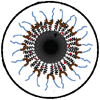Department of Physics and Astronomy: Publications and Other Research

Diandra Leslie-Pelecky Publications
Document Type
Article
Date of this Version
2008
Abstract
Women remain underrepresented in science professions. Studies have shown that students are more likely to select careers when they can identify a role model in that career path. Further research has shown that the success of this strategy is enhanced by the use of gender-matched role models. While prior work provides insights into the value of using role models, it does not explain the cognitive process involved in girls identifying role models from nontraditional careers for women. This feminist study addresses this gap by examining the cognitive process eighth-grade girls use in identifying a person as a science role model and comparing it to the process used by women scientists seeking to serve as possible science role models. Data revealed that the girls’ process in identifying a role model involved personal connections and their initial image of a scientist led them to believe they could not have such a connection with a scientist. The initial views expressed by the women suggested they felt pressure to portray “perfect” scientists in order to be a role model. A common understanding of a science role model was realized only after changes occurred in the girls’ image of scientists and the scientists’ image of a role model. The catalysts for these changes were the relationships that developed between girls and women scientists.


Comments
Published in Science Education 92:4 (2008), pp. 688–707; doi 10.1002/sce.20257. Copyright © 2007 Wiley Periodicals, Inc. Used by permission. http://www3.interscience.wiley.com/journal/32122/home